
"JUST THE TICKET" - 1960s adventures in London RTL1050 (by Dick Gilbert)

Last updated 1 April 2018
SOME LINKS WITHIN THIS WEBSITE: Home Email Links THE COMPLETE WEBSITE MENU Events Diary Halfcab list Small-Ads Classic Irish Buses Classic Manx Buses
An article produced in conjunction with  and with the cooperation of Alan Bissell.
and with the cooperation of Alan Bissell.
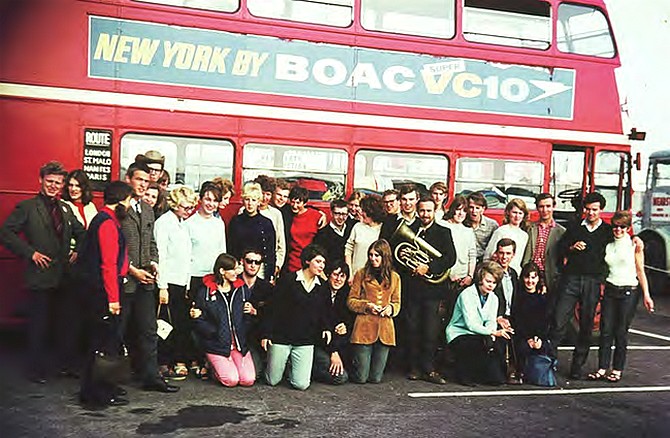
Please don't distract the driver! In 1965 the Double-Decker Club went to the Loire Valley, France. Romance blossomed for some on this trip...
In the mid-Sixties, a holiday across the Channel was still the stuff of dreams for most Brits. So, taking unlikely inspiration from Cliff Richard, a group of enterprising young Londoners bought a bus and set about gaining their first taste of European travel. More than 50 years on, Michael Wright meets the pioneering Double-Decker Club - now planning a reunion.
On 7 February 1964 a classified advertisement appeared on the front page of The Times. "Young people over 18. See Europe in a double-decker bus. July 25 - Aug 16. 6 countries. Student-run. £28 absolute maximum. Probably less. Phone POP 1841."
The advert was placed by 22-year-old law student Tim Lewis, who had come up with the idea for the tour after buying an obsolete bus from London Transport for £400. Actually, it was Cliff Richard in Summer Holiday (1963) who came up with the idea. In the film, Cliff and friends have a high old time driving around Europe in a double-decker London bus. And this is exactly what Tim did.
As dream holidays go, a package tour that involves camping with a bunch of strangers while spending a sweaty three weeks seeing Europe from the inside of an obsolete vehicle that is hot, slow and noisy as a steam kettle may not be everyone's idea of the trip of a lifetime. But wind the clock back to swingin' 1964, and make that vehicle a gleaming red double- decker bus still resplendent in its London Transport livery, fill it with youthful pleasure-seekers, and everything changes. (It helped that the contract from London Transport, demanding that the bus be repainted in less distinctive livery arrived after the sale had already gone through.)
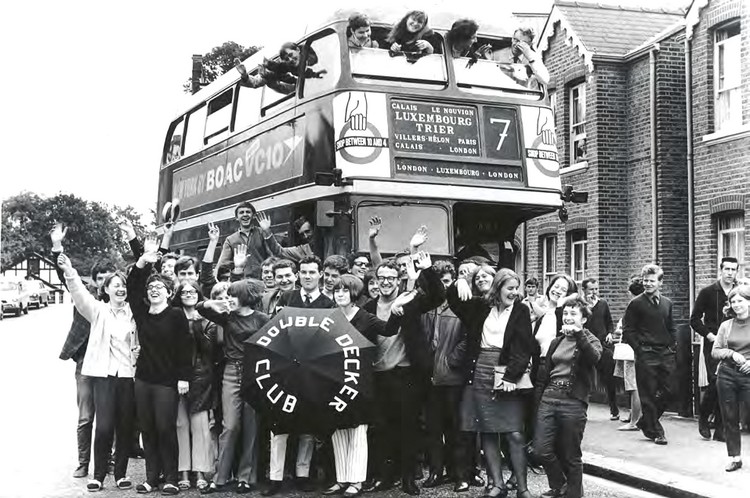
FUN AND LAUGHTER ON A SUMMER HOLIDAY. Setting off from the streets of Twickenham for Luxembourg and Trier in August 1966. That's Mike Hodges, one of the original organisers, holding the umbrella.
"I just thought it would be a bit of fun," laughs Tim, now 74. "I had no idea I'd end up having a career in public transport." The trip somehow captured the spirit of the age. Indeed, eager young cinema-goers waiting to see the Beatles movie A Hard Day's Night in July 1964, were first treated to a newsreel from British Movietone News "Her destination board's an eyebrow-raiser; her route, the Route Nationale," intones the presenter in his clipped post-war vowels, as the black-and- white footage shows a group of bright young things who are pretending to scrub and polish a London bus with the words BELGIQUE - NEDERLAND - DEUTSCHLAND - FRANCE on its destination board. "This is one of the most unusual and enterprising holiday ideas of the season: 40 youngsters, students from all over the country, will be spending the next three weeks driving around the Continent on a camping holiday... a round trip of about 2,000 miles. You might have been one of them, if only you'd answered an advertisement in The Times last winter."
That first trip was a huge success. The bus attracted press attention and public curiosity wherever it went; in Douai in northern France the mayor insisted on laying on a civic reception. "Those were the days when, if you met another British vehicle of any sort, you waved," says Tim. "You can imagine how astonished people in France were to see a double-decker bus meandering through their village. More than once, cars went into the back of each other as their drivers stared open-mouthed."
So began a series of European tours and the formation of the Double-Decker Club (DDC) to help organise them. "The fact that we were in a red London bus added everything to the holiday," says Kevin McCormack, 68, who went on two of the DDC's European trips when he was a 20-year-old civil servant in the Ministry of Aviation. "We had only to stop to fill up with diesel at a garage, and a French television film-crew would appear. And when we drove through one little village, the local newspaperman made us stop and do it all over again, so that he could take a picture for his paper."
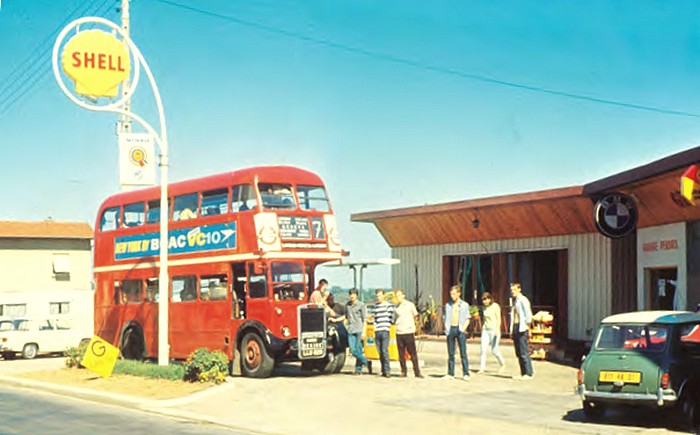
Are we nearly there yet? Refuelling near Bourg-en-Bresse, about 70 miles from Geneva.
Besides punctures, the biggest problem the travellers faced was low bridges. According to Kevin, the tightness of the clearances sometimes meant going under bridges an inch at a time. It meant one large dent and frequent detours. "We'd go down a country lane to avoid a bridge," he says, "and one day these French labourers in the fields all stopped working and started waving at us as if we'd come to liberate them. It was really quite emotional."
Mike Hodges, now 73, was a compositor, and booked The Rolling Stones for a college gig for just £60 the same year as the first trip. "I'd met Tim through the Young Liberals and ended up as navigator. We had a navigation table upstairs and a crude intercom. I used Michelin maps as at the time they were the only ones that gave bridge heights." It may seem like something of a madcap, let's-head-in-that-direction affair but, as Mike says, "We had to get to the camping sites on time as they were always heavily booked during the summer."
There was quite a social mix on board, Mike recalls. "On one trip we had Margaret Donaldson, the daughter of the Chief Justice, and my old friend Bob, a railway signalman. We'd always try to meet the passengers before we left to make sure everyone got on together"
With its noisy ten-litre engine, huge leaf springs, open-back platform and no heating, the 56-seater RTL bus, LLU 829, on which the holidaymakers travelled, was hardly the height of luxury. For the European trips, most of the downstairs seating had been removed to make room for camping equipment and, unlike Cliff's bus in Summer holiday, there was no bathroom, dressing-room or galley. Instead, the sole technical improvement that Tim Lewis had made to his bus was to drill a dirty great hole in the floor upstairs, so that whoever happened to be navigating could yell down to him whether to turn left or right. "There was no power-assisted steering in those days," he recalls, "I think my chest measurement went up two inches in those first few months of owning the bus because you really did need some muscle to get round corners."
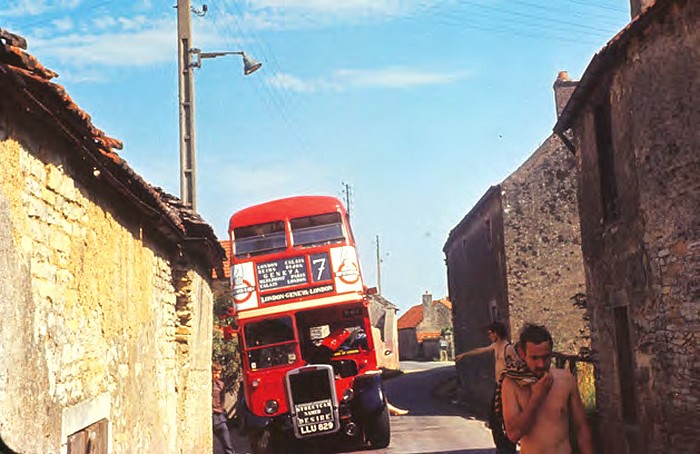
Engine - and passengers - cooling off in Chalon-sur-Saone, eastern France.
Being a driver did, however, have its compensations. "There's a curious sense of privilege in being behind the wheel of a double-decker bus," says David Snell, 73, who drove the 1966 trip to Geneva and ended up working full-time with Tim in later years. "I always used to get a buzz when we got to the ferry and you had to reverse the damn thing onto the boat. You got quite a lot of kudos from the passengers, too - especially the girls. At the age of 25 or 26, that wasn't too bad."
RTL buses were notorious for the alarming way they leaned when cornering. Yet, judging from the recollections and photographs of those who actually went on the trips, discomfort was the last thing on their minds. This was, after all, an era when people didn't readily complain. Everyone on the bus was simply having a high old time, with the open-back platform becoming one of the most sought-after riding positions, along with the three prized perches on the bonnet or the front wing. Bemused, the gendarmes turned a blind eye.
Romances were common on the trips, according to Tim, and a number of marriages arose out of them. He himself met his wife on the second trip, in 1965. But he doubts that anyone ever came on one because they were actively seeking romance, and says that it was always harder to persuade men to come than women. "The women were coming for a cheap holiday - a social time," he says. "My wife came with a fellow nurse, for instance. At that time, £28 was a typical week's wage. And as the trip cost only £23 in the end, we gave them all back a fiver or so."
Also on that second trip was Alan Bissell, now 71, who was chairman of the Double-Decker Club and driving force behind a planned reunion of former members in London later this year. He agrees with Lewis's assessment of the trips' romantic element. "Yes, it was a bit hippyish, and these were, of course, the days of free love. But the trips weren't sleazy. They were just great fun"
Besides the tours to the Continent, the DDC organised dances and bring-and-buy sales, as well as day- trips by bus to Brands Hatch and the Isle of Wight. But it was the foreign trips that left the indelible memories. "On the 1965 trip to Basel, before I became one of the DDC drivers, I spent a good part of the holiday sitting on the bonnet, driving across central France at probably 45mph," recalls Alan. "When I think about it now, it's bloody scary" So he won't be riding on the bonnet at the reunion? He shakes his head. "I think that, as a Justice of the Peace, I might find myself in an awkward position if we got stopped."
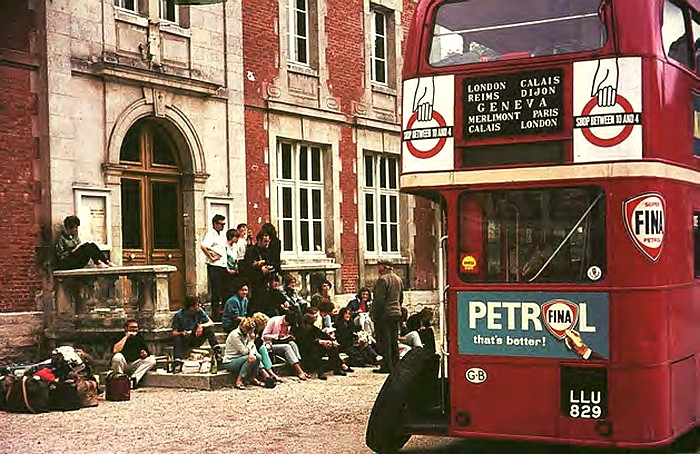
1966, GENEVA OR BUST; This puncture (just one of many) resulted in an unscheduled rest stop at Oulchy-le-Chateau in Picardy, northern France.
How far the world has turned since the carefree days of the sixties. "I don't think trips like this would work now," says Kevin, sadly. "They'd probably need to have seatbelts on the bus. You certainly wouldn't be allowed on the platform or the bonnet. That's why it's lovely to be reliving those former times. Nowadays, everybody expects someone else to keep them safe. Back then, we were reliant on ourselves."
David Thrower, who now owns and has lovingly restored LLU 829, nods. He was still at school when the bus was travelling all over Europe, so never went on one of the tours. But he is full of admiration for those who organised them. "Even if I'm just driving the bus down to the pub, I'll put tools and extra water on board," he says. "Whereas they waltzed off to Geneva without a care in the world. It was an extraordinary feat, to have taken so many people so far. I take my hat off to them, and it was wonderful to connect up with them and that era when we met up to do the photographs. These people technically are pensioners. But you wouldn't know it, because they really are firing on all cylinders." And so, too, following a complete engine rebuild and the careful repair of a dirty great hole in the upstairs floor, is their beautiful London bus.
My thanks to Saga Magazine for permission to reproduce this article.
====================================
BUS STOP REUNION
Were you a member of the Double-Decker Club or one of the 400-plus people who went on the trips between 1964 and 1969? Five of the groups original organisers are arranging a reunion in the spring of 2016, and want as many people as possible to attend. "It would just be lovely to see some of them again, says Tim Lewis. Meeting up for the Saga Magazine photo shoot was an emotional moment - I hadn't seen some of those guys for more than 40 years."
Email alan@elmswood1.plus.com or write to Alan Bissell, Elmswood, Allt Goch, Flint, Flintshire CH6 5NF.
====================================
MEET THE BUS
Even in 1964, LLU 829, the bus bought by Tim Lewis for his early European tours, was outmoded. But it did have one unique feature: the signatures of all four members of the Fab Four scrawled on the ceiling upstairs, This was because the bus was used for a scene in A Hard Days Night, which sadly never made it into the final edit. Further film appearances followed, inducing a starring role with Sidney Poitier and Julie Christie in To Sir With Love and cameo performances in a further 18 movies.
The bus was converted into an open-top vehicle in the Seventies and was used by Kenny Ball and his Jazzmen on tour, but by the mid-Eighties, it had been relegated to a holiday park shuttle in Kettering where, unloved and ignored, it began rapidly to decay. Fortunately, bus enthusiast David Thrower - who, at 64, is about 8 weeks older than LLU 829 - bought the bus for £750 and has since lovingly restored it to its original closed-top condition, using the roof from a second bus purchased from a scrapyard for £250. "I felt I had to restore it and look after it, because it's of great historic and sentimental interest. I'm its caretaker now," He pauses, "When you're an enthusiast, you just feel you have a duty to do this stuff. Some people say I'm crazy, but I just can't help it, We're all in it together, aren't we?"
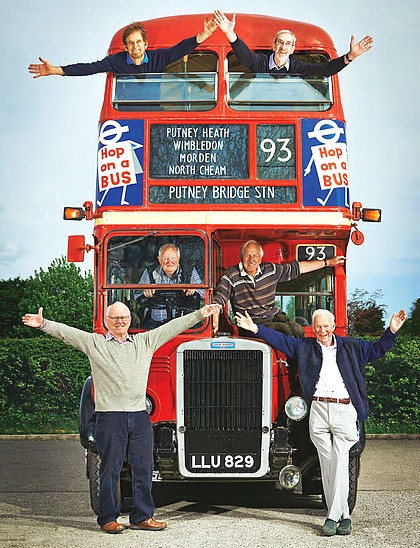
The gang reunited in the summer of 2015. David Thrower (left) and Alan Bissell are on the upper deck; Tim Lewis is behind the wheel again; Kevin McCormack is on the bonnet; and Dave Snell (left) and Mike Hodges are standing in front of the recently restored bus.
====================================
For more London buses see the AEC Renown single-deck LT class, AEC Regal T class, the Leyland Tiger PS1 TD class, the Trolleybus/Routemaster conversion programme, and the Routemaster.
.For many other buses, have a look at all the other profiles on the Classic Buses menu page.
SOME LINKS WITHIN THIS WEBSITE: Home Email Links THE COMPLETE WEBSITE MENU Events Diary Halfcab list Small-Ads Classic Irish Buses Classic Manx Buses